The Bahama Islands are home to at least twenty-one marine mammal species, including some of the world’s most bizarre looking creatures. In 1991, Ken Balcomb and I founded the Bahamas Marine Mammal Survey to find out which leviathan species occur here, the seasonality and frequency of their occurrence, and to determine their population size and status, if possible. Today, with support from Earthwatch, we carry out surveys and photo-identification studies of marine mammals based from Hole in the Wall light station in Abaco.
Our Survey efforts have been greatly enhanced by sighting reports and photographs that we receive from boaters traveling through the islands. The following is information on whales and dolphins that are commonly seen in the Bahamas to aid and encourage boaters to continue to report sightings to us.
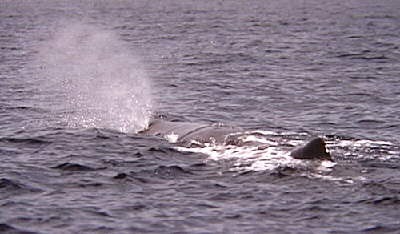
Sperm whales (Physeter macrocephalus) are the largest toothed whales in the world; adult males can grow up to 60 feet, although adult females are considerably smaller, reaching 35-40 feet in length. Sperm whales have a huge squarish head that is about one third the body length. With a single nostril on the left side and their wrinkled brown skin, these whales may have the appearance of a floating, occasionally breathing, log resting at the surface. However, if approached by a boat, a sperm whale will slowly move away and usually raise its tail in preparation for its dive, thus allowing researchers to take a photograph of the underside of the tail showing their individually distinctive patterns of notches. Adult female sperm whales appear to be regulars to the Bahamas and are found here year-round in nursery pods. The mature males frequent the islands during the winter months in search of receptive females for breeding purposes, but spend the rest of the year feeding in higher latitudes in order to sustain their massive bulk of 60+ tons.
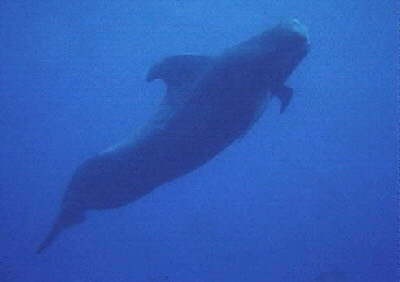
Short-finned pilot whales (Globicephala macrorynchus), also known as blackfish or potheads, usually grow to 18 feet long and weigh about 5,000 pounds. They are jet black and have a large, bulbous head with a faint white diagonal stripe bephind each eye and a white or gray cape behind and below the dorsal fin. Their large, falcate dorsal fin is set quite far forward on their body. Pilot whales live in large matrilineal pods of 50-100 animals consisting of up to three generations of related females, which on calm days can be seen resting at the surface for hours in tight groups lying abreast. Pilot whales can be confused with 3 other blackfish species (melon-headed whales, pygmy killer whales and false killer whales), but look sharply and note that these latter species have a relatively taller dorsal fin in the middle of their back and they lack the white eye stripes and cape of pilot whales. It is probable that many of the pilot whales seen in the Bahamas are year-round residents.
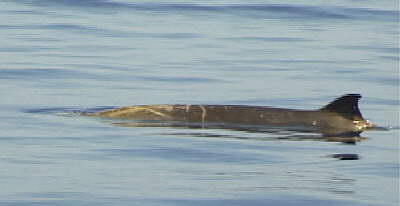
Dense-beaked whales (Blainville's beaked whale, Mesoplodon densirostris) are but one of at least three beaked whale species found in the Bahamas. Dense-beaked whales are a small (14-16 foot) brownish-tan cosmotropical whale with white, oval scars on the back from cookie cutter sharks, and longitudinal paired tooth scratches inflicted by congeners. Beaked whales in general have a small hooked dorsal fin that is located about two thirds of the way back along their body. They have a pronounced beak or rostrum, which breaks the water first as the whale surfaces to breath. The rostrum of male dense-beaked whales consists of the densest bone known on earth. In the steeply arched lower jaw of this species there are only two teeth, and these only erupt above the gumline in sexually mature males. These hornlike teeth are apparently used in combat with other males perhaps as part of a dominance display. Judging from the antiquity and layering of scars, the combat is typically sub-lethal, but often severe. The males have dense clusters of stalked barnacles growing on their jutting teeth, giving them the appearance of a strange sea monster. The females we studied remained year-round in the islands. On the other hand, although adult males can be seen during all months, it is still unknown whether or not the same individuals remain here year-round.
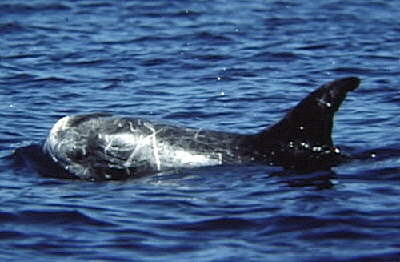
Risso’s dolphins (Grampus griseus) are generally gray in colour but have a white head and extensive white scarring on the backs of adults and elders. These large dolphins have a rounded head with a deep crease down the center of the forehead. Individuals grow to 12+ feet and have a relatively tall dorsal fin. On the Atlantic side of the northern Bahamas, Risso’s dolphins appear to move inshore towards the coast in the winter and spring perhaps following prey. It is yet unknown where they range the rest of the year, but some individuals have been seen off the coast of Abaco repeatedly over the past five years. Risso’s dolphins are often confused with pilot whales at a distance, but in the right lighting the white heads are very prominent.
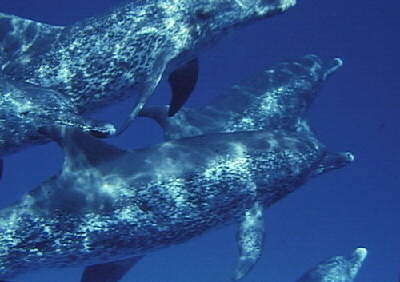
Atlantic spotted dolphins (Stenella frontalis) grow to 8 feet, but are not always spotted! Newborns and juveniles do not have spots, but accumulate them as they mature, becoming quite mottled looking as adults. Generally found in groups of 30-50 animals, spotted dolphins will ride a boat’s bow-wave and usually put on a spectacular aerial show. In some parts of the Bahamas, spotted dolphins can be quite friendly: but, please if you enter the water, do not attempt to touch them as it may provoke an aggressive response. Spotted dolphins occur on both the shallow banks and in the offshore waters, feeding on squid and flying fish along the "drop-off" at night-time and resting on the shallow banks during the day.
As cruisers, you have a unique opportunity to observe these animals and other rarely seen marine mammal species. It is important to keep an accurate log, take photographs and/or video, and to be an ardent observer, while respecting the animals’ needs for space. With the continued help of boaters cruising the islands, we hope to further our awareness of marine mammals and to gain a better understanding of their conservation needs in this part of the world in order to provide protection for these species and their habitats.
(from The Bahamas Cruising Guide by Matthew Wilson,
International Marine-McGraw-Hill, 1998, ISBN 0-07-052693-1)
| Home | Return to Top of Page | Email the Center for Whale Research |